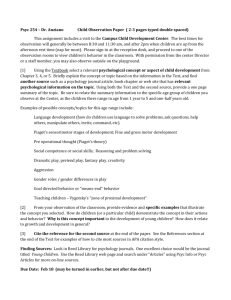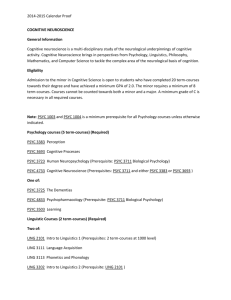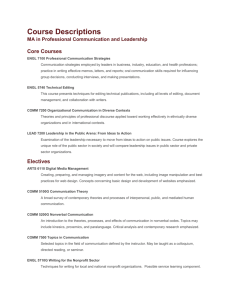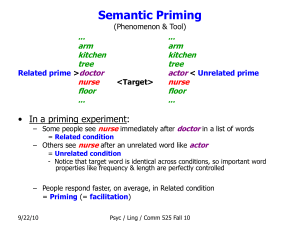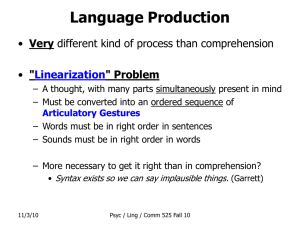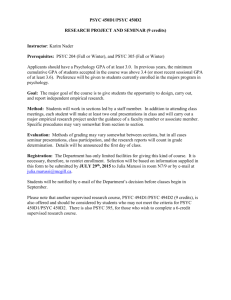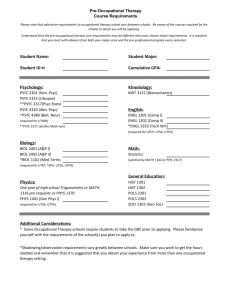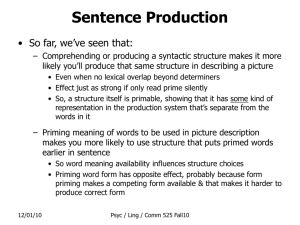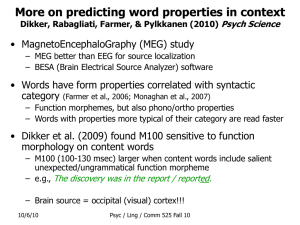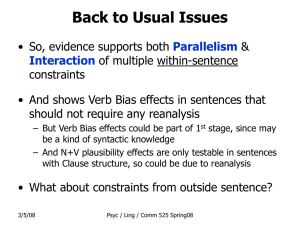Speech Perception
advertisement
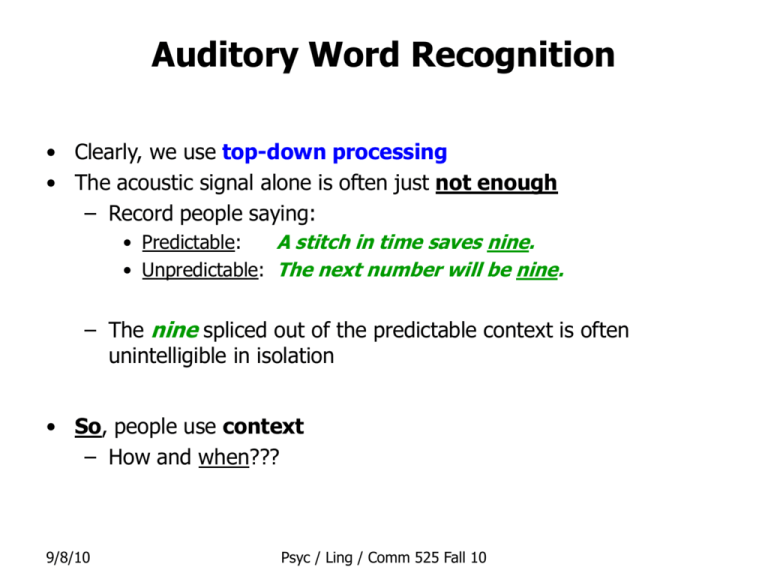
Auditory Word Recognition • Clearly, we use top-down processing • The acoustic signal alone is often just not enough – Record people saying: • Predictable: A stitch in time saves nine. • Unpredictable: The next number will be nine. – The nine spliced out of the predictable context is often unintelligible in isolation • So, people use context – How and when??? 9/8/10 Psyc / Ling / Comm 525 Fall 10 Phoneme Restoration • Replace one phoneme in an utterance with noise – If the phoneme is predictable from context, people “hear” the missing sound (e.g., legi*lature) – If tell them a sound has been replaced, they’re not accurate at identifying which sound it is – Warren & Warren (1970) • Stimuli (acoustically identical except for last word) – – – – It was found that the *eel It was found that the *eel It was found that the *eel It was found that the *eel was on the orange. was on the axle. was on the shoe. was on the table. • People believed they had heard the phoneme that made sense given the final word – Final word can’t have influenced what they heard at *eel 9/8/10 Psyc / Ling / Comm 525 Fall 10 Zwitserlood (1989) (Tests predictions of Cohort Model - Zwitserlood was Marslen-Wilson’s student & this was her dissertation) • Cohort Model framework – How much information is retrieved about all the activated cohort members (=competitors) before selection? – How early in word recognition does context influence processing? 9/8/10 Psyc / Ling / Comm 525 Fall 10 Possible Timecourse of Context Effects From Zwitserlood (1989) 9/8/10 Psyc / Ling / Comm 525 Fall 10 Methods • People heard sentences that ended with a critical word (e.g., kapitein) – Critical words had clear competitors before their uniqueness point (e.g., kapit^aal) • At one of several timepoints during the critical word, a visual word that was semantically related to either the critical word or its competitor (e.g., schip or geld) appeared on screen – Task = lexical decision – Cross-modal priming paradigm • Use response to target to tap into processing of prime – Early test points intended to determine how early context can rule out inconsistent competitors – Test points determined separately for each critical word by results of gating study 9/8/10 Psyc / Ling / Comm 525 Fall 10 Stimuli • Gating study – People heard successively longer fragments of critical words – In 3 kinds context • Carrier phrase: The next word is kapitein. • Neutral context: They mourned the loss of their kapitein. • Biasing context: With dampened spirits the men stood around the grave. They mourned the loss of their kapitein. • Control context: The player got the ball and scored the winning goal. – Guessed what the word was – Recognition point = Point in word where everyone identifies it as the critical word • Often earlier than uniqueness point • How much earlier typically depends on degree of contextual constraint – Get to see what competitors are produced before recognition point 9/8/10 Psyc / Ling / Comm 525 Fall 10 Visual Probe Positions (for each critical word) Isolation point = Timepoint in word when the critical word first given as a response by a participant & after which it’s the only response for that participant (mean across participants) 1. Isolation point in Biasing Context (Mean = 133 msec; lexical access) 2. Isolation point in Neutral Context (Mean = 199 msec; lexical access) 3. Isolation point in Carrier Phrase (Mean = 278 msec; selection) 4. Recognition point in Carrier Phrase (Mean = 410 msec; integration) Probes = schip or geld 9/8/10 Psyc / Ling / Comm 525 Fall 10 Results Probe positions 1 & 2 -Probes related to both Critical Word & Competitor primed by hearing some of Critical word, compared to Control condition Here’s where enough of word heard to start choosing target over competitor Probe position 3 - Hear enough word that target more active than competitor in Carrier Phrase (= selection) - Only then does Biasing Context have an effect Here’s also where biasing context first starts to have effect -So, context does not influence word recognition until enough bottom-up information to start selecting word from cohort schip geld 133 9/8/10 199 278 From Zwitserlood (1989) Psyc / Ling / Comm 525 Fall 10 410 Conclusions • The results of this study led to the revision of the Cohort Model such that context effects can only come in relatively late 9/8/10 Psyc / Ling / Comm 525 Fall 10 Allopenna, Magnuson, & Tanenhaus (1998) Tests predictions of TRACE Model • An important difference between Cohort & TRACE models – Difference in degree of constraint provided by word onsets compared to rest of word is bigger in Cohort Model – Previous work had not found any clear effects of competitors that didn’t share onsets • Allopenna et al. tested this by including competitors that shared onsets vs rhymes 9/8/10 Psyc / Ling / Comm 525 Fall 10 Stimulus Words From Allopenna et al., 1998 9/8/10 Psyc / Ling / Comm 525 Fall 10 Results of running simulations for these items in TRACE Model Rhyme competitor “speaker” becomes almost as active as cohort competitor “beetle”, though later of course From Allopenna et al., 1998 9/8/10 Psyc / Ling / Comm 525 Fall 10 Methods - Instructions: “Point to the …” -Display contains: - Target beaker - And at least one of: - Cohort competitor beetle - Rhyme competitor speaker - Unrelated word carriage -Participants wore head-mounted eyetracker - People tend to look at objects that are mentioned - especially before reaching for them - How quickly do they look at the objects related to the target word? 9/8/10 Psyc / Ling / Comm 525 Fall 10 Predicted fixation probabilities based on TRACE simulations 9/8/10 Psyc / Ling / Comm 525 Fall 10 Fixation Probability Results 9/8/10 Psyc / Ling / Comm 525 Fall 10 Comparison of data to model predictions Target & Cohort Competitor Target & Rhyme Competitor Model slightly overpredicts fixations to Target & slightly underpredicts fixations to both Cohort & Rhyme competitors 9/8/10 Psyc / Ling / Comm 525 Fall 10 Gating Study TRACE Model Predictions Object choice (pointing) data - Maybe results of first experiment specifically due to having competitor objects visually present? - What would happen in a task using same display but that emphasizes auditory word onsets? 9/8/10 Psyc / Ling / Comm 525 Fall 10 Gating Study – Fixation & Pointing Results Model vs Fixation data Model vs Pointing data - So, it’s not the presence of the visual object with competitor names that led to the results in Experiment 1 - Experiment 1 provided the first clear evidence of activation of Rhyme competitors - which lends support to the TRACE Model over the Cohort Model - & which led to further revision of the Cohort Model 9/8/10 Psyc / Ling / Comm 525 Fall 10
